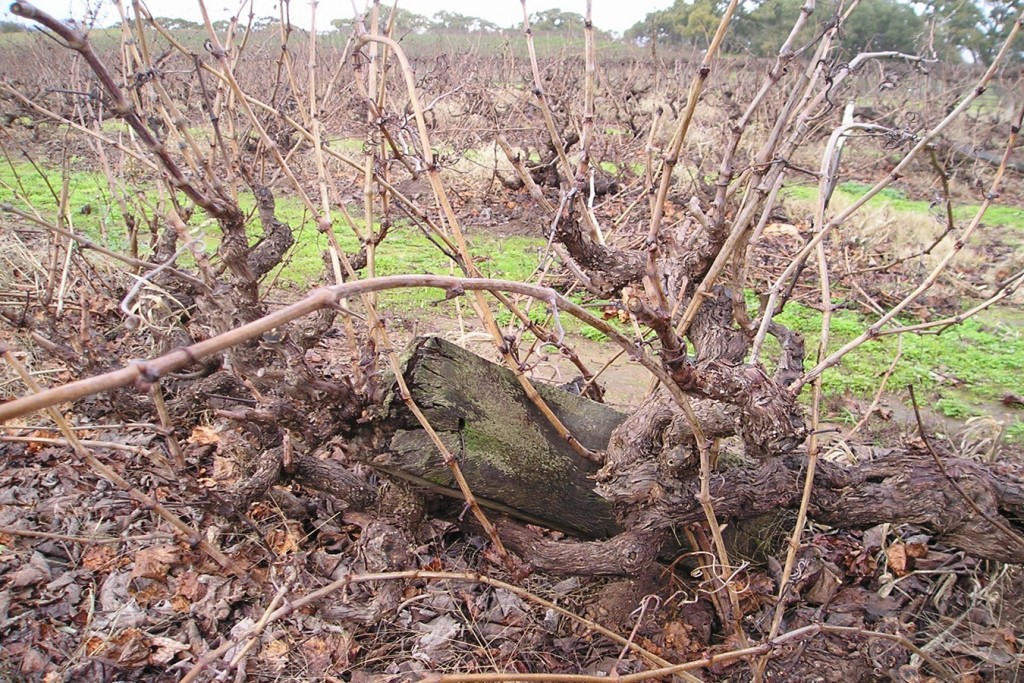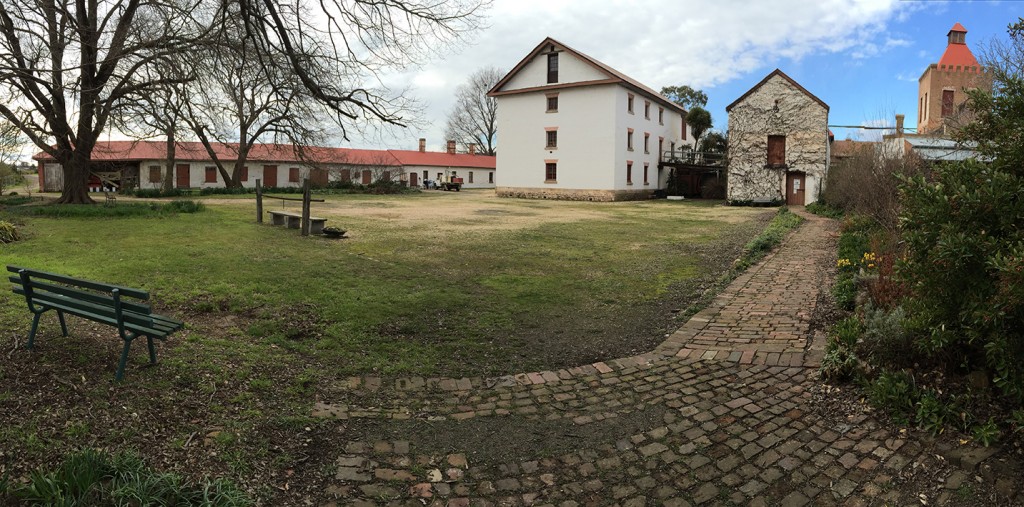One of Canberra’s earliest, biggest, shortest and potentially most beautiful vintages peaked in late March. By month’s end, only a rump of cooler, higher vineyards, late-ripening varieties and grapes destined for dessert wines remained to be picked.
Late on Saturday 21 March, Murrumbateman winemaker Ken Helm rang the old cellar-door bell, signalling vintage end. He’d just harvested the usually late-ripening cabernet sauvignon. “It’s the earliest vintage in my 39 years here. It’s also our biggest crush, and the winery’s full”, said Helm.
Helm believes 2015, “has outdone even 2013. It ticked every box and is the best across all varieties. If we get a better vintage than this, I’ll be very, very surprised. It’s a cracker”.
Like other winemakers in the area, Helm struggled to process an unending stream of fruit. “Our biggest problem was tanks”, he said. But daughter Stephanie and husband Ben Osborne, owners of nearby Yass Valley Wines, helped with the overflow.
Hall’s Allan Pankhurst completed harvest the same day as Helm, bringing in tempranillo and sangiovese a couple of weeks earlier than usual. Christine Pankhurst said, “everything was ripening at the same time this year, so everyone’s been stretched”.
In most vintages, a gap in ripening times for different varieties gives winemakers time to clear fermenters between batches. But, says Allan Pankhurst, the compressed vintage filled cellars to overflowing – and a few neighbours borrowed half-tonne grape bins for their ferments.
Pankhurst rates 2015 “a bit better than 2013”, with high quality across the board and, for him, “tempranillo and pinot noir the standouts”.
He says, “We knew it would be an early vintage because flowering and veraison [the point where grapes begin to soften and ripen] were both two weeks early. We also expected a compact vintage because the late ripeners, sangiovese and tempranillo, went through veraison at the same time as the earlier ripening varieties”.
But the season produced its nervous moments. At Lerida Estate, Lake George, Jim Lumbers described going, “From despair to ecstasy. Rain and warm weather in January set up conditions for bunch rot. But the rain stopped and the weather slowly got sunnier and sunnier. Despite forecasts of rain, the weather remained clear”.
Despite good yields and high fruit quality, the vintage became something of an ordeal, said Lumbers, when everything ripened at once. He said, “We’ve had very late nights, our capacity has been stretched but coping. We’ve been picking and processing every day with no breaks”.
By 21 March, most of Lerida’s fruit was in the vat. Lumbers expected to pick cabernet franc on 23 and 24 March, shiraz in the first week of April and pinot gris for dessert wine around mid-April.
Lumbers expected the 2015 harvest to equal that of 2008, the biggest on record to date. Quality, too, is very good, especially the “dramatic, wonderful, clean” merlot and “spectacular” cabernet franc.
At Mount Majura wines, Frank van de Loo reported an early vintage with overall crops a little above estimates. Chardonnay came in lower than expected, but riesling yielded around nine tonnes to the hectare, well over the targeted yield of seven tonnes.
The compact harvest meant a frantic time in the winery, said van de Loo. While the whites, pinot noir, cabernet franc and merlot had all been harvested by 21 March, tempranillo and shiraz picking was to begin on 22 March and progress according to ripeness.
Van de Loo notes great colour and flavours resulting from the mild season, and a good balance of sugar and acidity.
Good volumes allow for a little staff experimentation, said van de Loo. The cellar-door crew crushed pinot gris on 21 March. Towards the end of fermentation, they’ll add a little red wine, then bottle the blend and allow it to complete fermentation – creating a naturally carbonated rose.
With a big pinot noir crop on hand, van de Loo is conducting a trial, based on Tasmanian research. He’ll produce a control pinot using traditional techniques, including extended maceration on skins. In a trial batch, to be compared with the traditional one, the skins will be cut, thus reducing the maceration time required to extract colour, tannin and flavour. The reduced maceration time should, in theory at least, reduce the extraction of hard tannins from the seeds, resulting in a smoother wine.
At Four Winds Vineyard, Murrumbateman, winemaker Bill Crowe praised, “The best fruit I’ve seen in the four years I’ve been here. It’s looking fantastic. Shiraz looks better than ever and it’s very clean. Riesling is as good as ever”. He added, “It’s a heavier crop than standard, despite dropping fruit”. (Winemakers often cut fruit from the vine to encourage complete ripening of the remainder).
Crowe expected all varieties to be in the winery by 20 March, with the exception of sangiovese, due for harvest between early and mid April. He anticipated crushing 57 tonnes this year (up from 10 tonnes four years ago), enabled by a crowd-funded winery expansion, “which we’ve maxed out once already, with more to come this Wednesday, Thursday and Friday [18–20 March]”.
Neil McGregor of Yarrh Wines, Murrumbateman, observed high quality and bigger volumes across all varieties. Sangiovese set a large crop and required fruit thinning around Christmas. But the other varieties ripened large crops with no need for thinning.
For Yarrh it’s a good year to double production of riesling and shiraz for its own label, reduce its push into exports and ramp up sale of fruit to other growers. “The big makers are buying as the fruit is fantastic”, said McGregor.
At Brindabella Hills, Hall, Roger Harris notes a “most amazing vintage. It arrived several weeks early, creating havoc organising picking. Vintage came all of a sudden, and it all ripened together. It was tight in the winery but we had just enough room for the last few pickings.
At 21 March, only small batches of grenache, cabernet franc and whites for dessert wine remained in Brindabella’s vineyard.
Graeme Shaw of Shaw Vineyards Estate, Murrumbateman, said he hadn’t seen shiraz better than the 50 tonnes harvested this year, nor had he seen better merlot. Shaw was due to harvest nine hectares of cabernet sauvignon on 25 and 26 March. Provided, the rain held off, Shaw anticipated very high quality. He called 2015 a disease-free year.
High up on the Lake George escarpment Lark Hill’s Sue Carpenter reported, “Spectacular fruit in both vineyards”. The Carpenters own the Lark Hill vineyard (Canberra’s highest, peaking at around 860 metres) and the warmer Dead Horse vineyard, Murrumbateman. Harvest had yet to commence in either vineyard, Carpenter said. So that’s a story for another day.
Nick O’Leary makes wine up on the escarpment, but sources most fruit from Murrumbateman, plus parcels from the old Westering vineyard, Lake George and Forest Hill, near Bungendore.
O’Leary described the vintage as excellent overall and probably, “The best red and white season combined that I’ve seen”. He processed 125 tonnes in a non-stop three weeks, up 40 per cent on normal. “Shiraz is some of the best I’ve seen”, he said.
Like other makers, O’Leary observed healthy, plump, juicy grapes, properly ripened, with no signs of shrivel. In turned this mean generally trouble-free, complete ferments. Healthy vine canopies, resulting from adequate ground moisture and mild temperatures accounts for much of this.
O’Leary is increasing production to satisfy growing demand for Canberra wines in Canberra, Sydney and Melbourne. Trade support in Canberra is the best he’s ever seen, said O’Leary.
By 21 March, Collector Wines had everything in the vat. Winemaker Alex McKay said quality is outstanding and “this is most obvious in the reds, though there’s a lot of good riesling. The best vintage to date has been 2013. But 2015 is up there and may be better”.
McKay said for the first time many growers achieved big crops but not at the expense of quality. While very good weather conditions helped, he believes Canberra has experienced a general overall improvement in vineyard management, fruit handling and winemaking.
At Capital Wines, Murrumbateman, winemaker Andrew McEwin, “Used every fermentation vessel” in a compressed and early vintage. He observed healthy, well-swollen grapes with good flavours and excellent balance of sugar and acidity. Shiraz from his old vines and merlot in particular are outstanding, he said.
Bryan Martin makes wine at Clonakilla, Murrumbateman for both the Clonakilla and his own Ravensworth label. Vintage was nearing an end by 21 March, with cabernet sauvignon, grenache, a small amount of shiraz and a few bits and pieces to go.
Martin reported big volumes – sufficient to fill Clonakilla’s greatly expanded winery – and very high quality, healthy fruit across the varieties. He said Clonakilla was making much more riesling and sauvignon blanc this year to meet increasing demand.
We can also look forward to several quirky 2015 experimental wines from Martin – another story for another day.
Our final word on Canberra’s 2015 vintage comes from veteran winemaker, Greg Gallagher of Gallagher Wines, Murrumbateman, “I think this is the best vintage I’ve done in this district”.
Copyright © Chris Shanahan 2015
First published:
- 25 March 2015 in goodfood.com.au
- 1 April the Canberra Times Wine and Food Magazine


